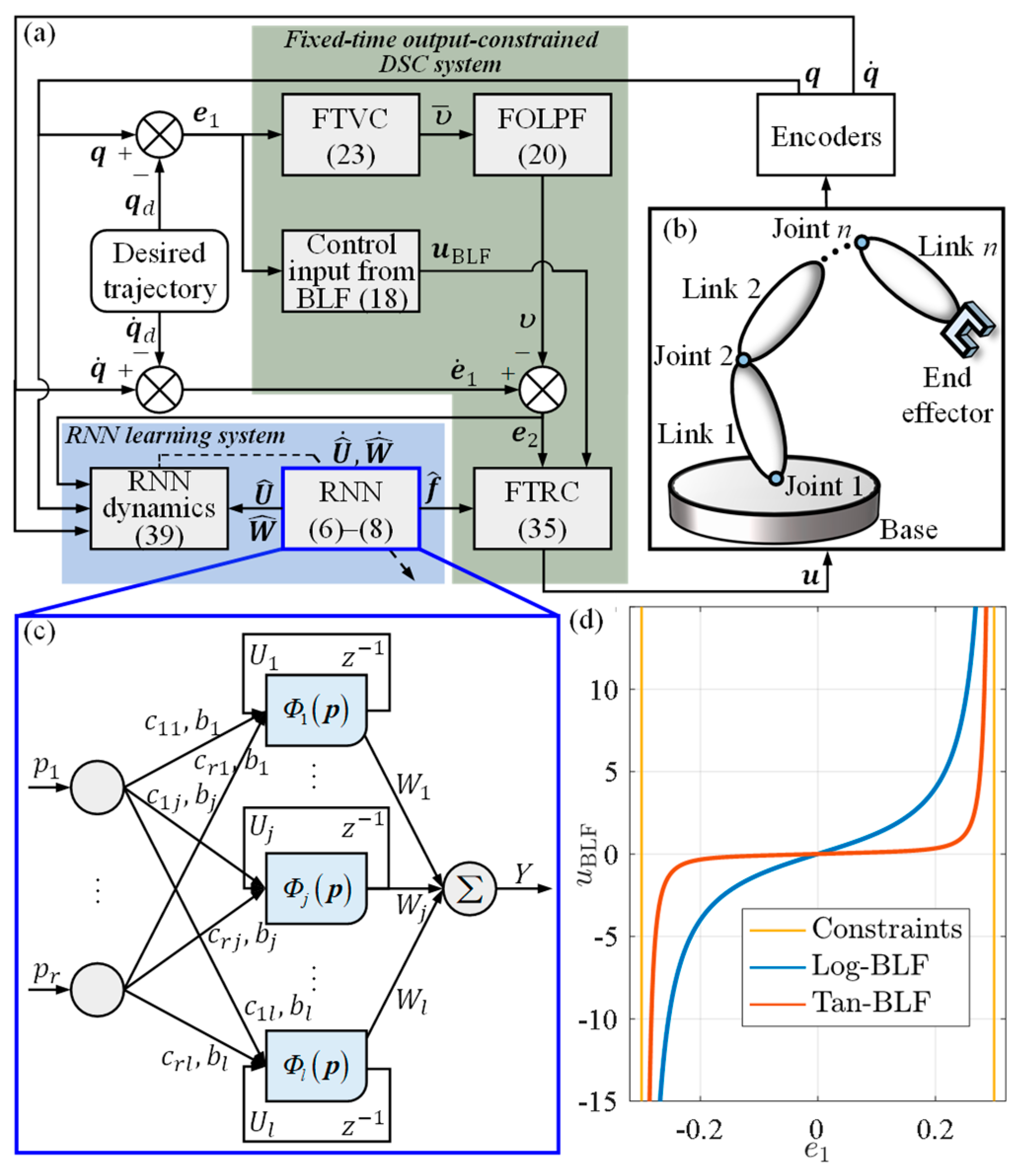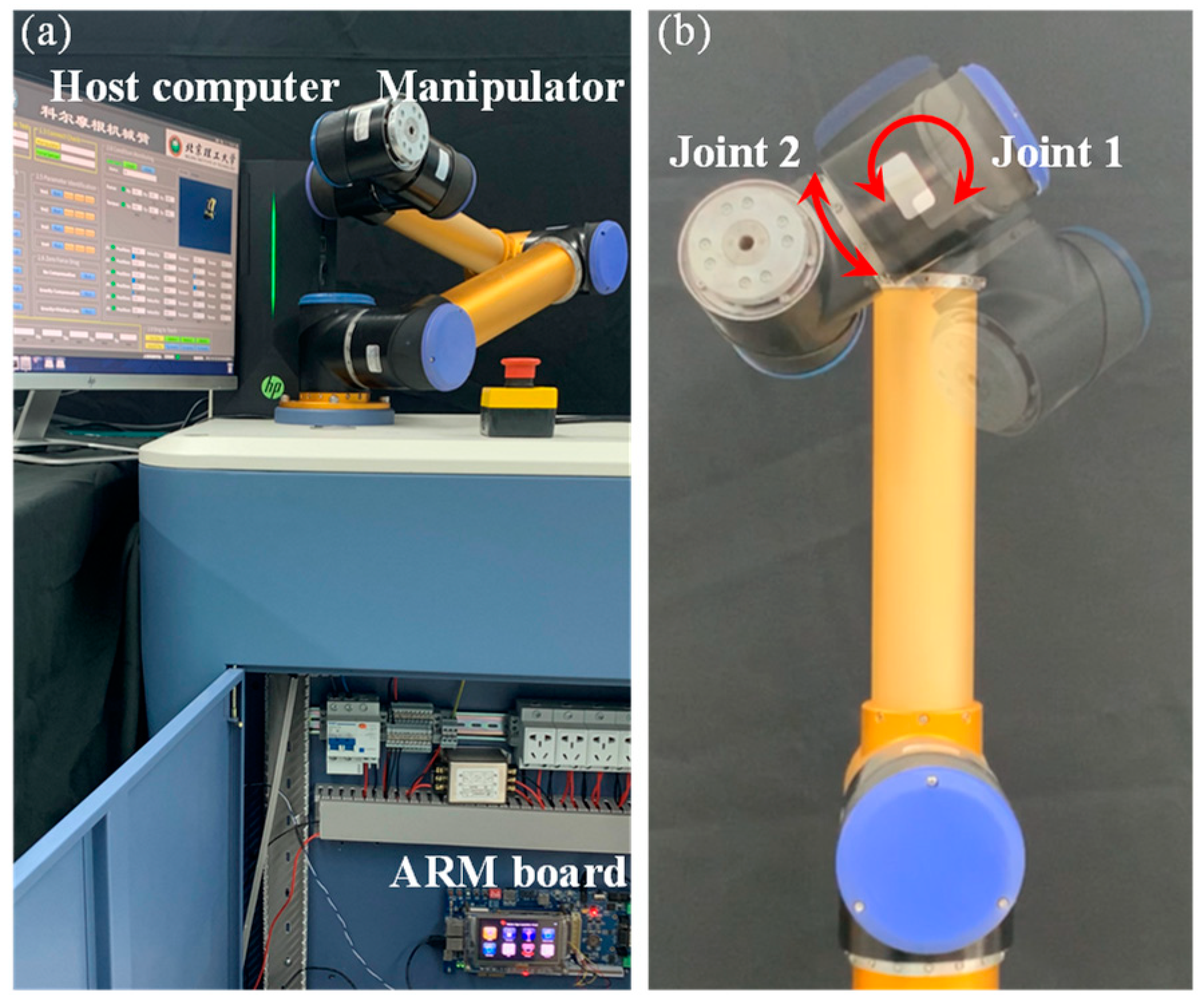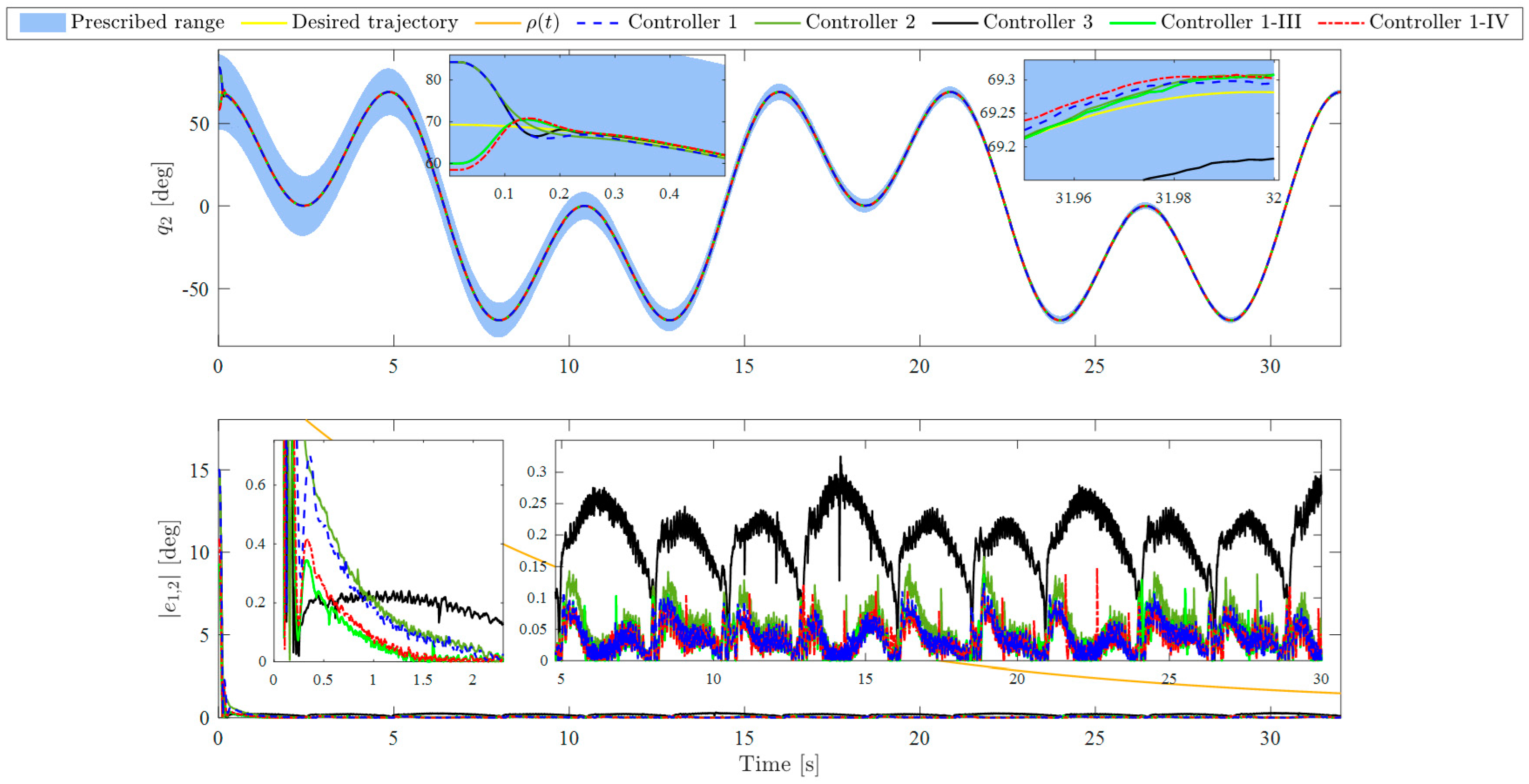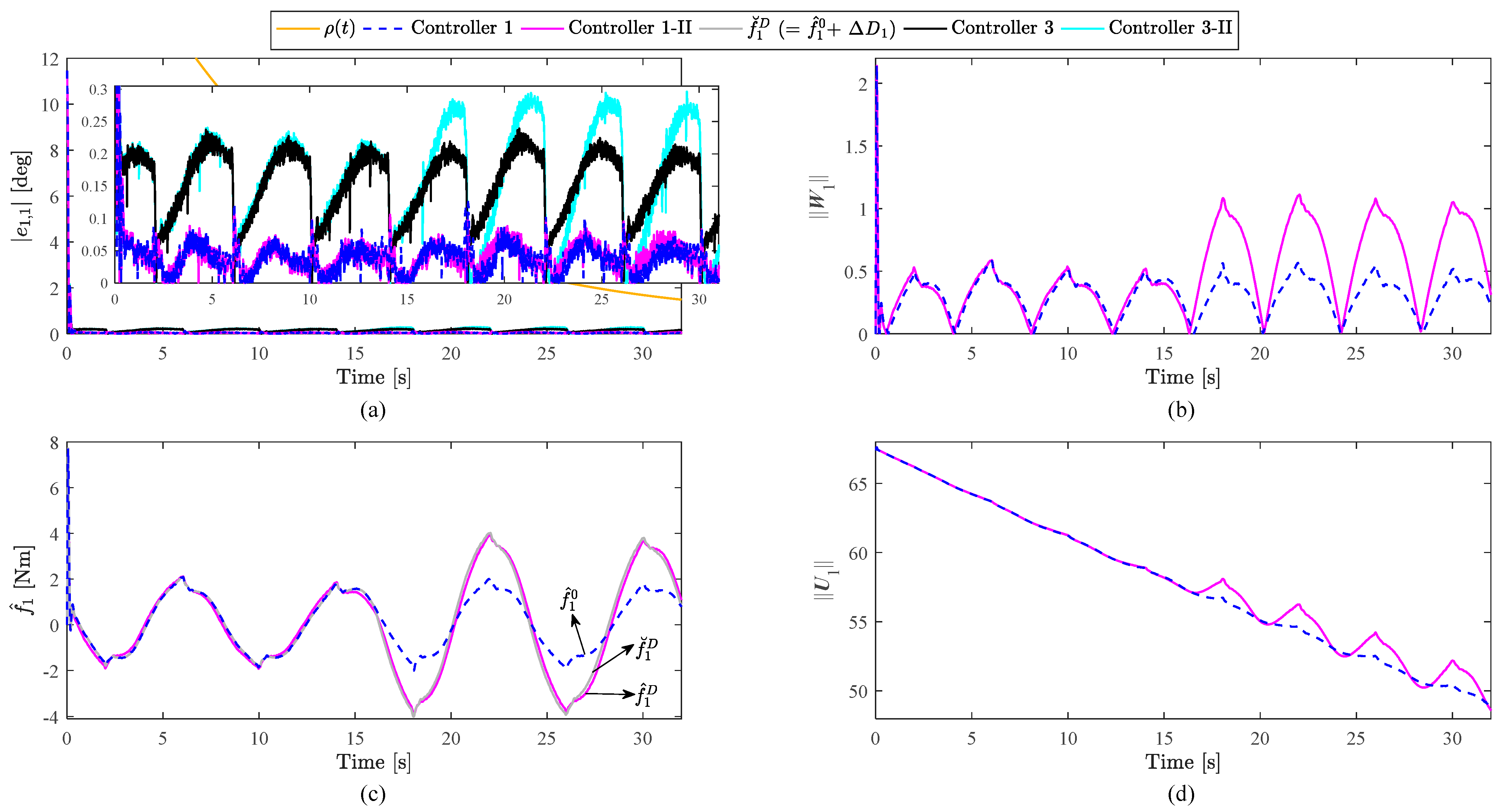Fixed-Time Recurrent NN Learning Control of Uncertain Robotic Manipulators with Time-Varying Constraints: Experimental Verification
Abstract
1. Introduction
- We propose a controller with the capability of disturbance rejection, uncertainties compensation, as well as constrained output, which satisfies practically fixed-time stable (PFTS).
- An accurate estimate of unknown dynamics and external disturbances is achieved by using an online RNN approximator. A novel RNN dynamics is derived based on Taylor expansion linearization. Furthermore, the RNN dynamics in a robust form are specially constructed to ensure the system stability more reasonably.
- For a class of time-varying BLFs, the Tan-BLF, which is a more general approach than Log-BLF [26] for the control with or without output constraints, is introduced to construct the FTVC, and the corresponding control input term derived from the Tan-BLF is incorporated as a component into the FTRC.
2. Problem Statement and Preliminaries
2.1. Notations
2.2. Problem Statement and Formulation
2.3. Preliminaries
3. Recurrent Neural Network (RNN) Construction
3.1. RNN Design
3.2. RNN Approximator
4. Fixed-Time Output-Constrained RNN Learning Control Framework
4.1. Fixed-Time Controller Design
- (1)
- If , we have
- (2)
- If , applying Lemma 3, we can obtainwhere . Suppose that there exist unknown constants and compact sets such that , . Based on inequalities (43) and (44), we havewhere is defined asSubstituting (45) into (42) and applying Lemma 2, we havewhere and .
4.2. Stability Analysis for Closed-Loop System
5. Experiments
5.1. Experimental System Setup
5.2. Comparison Studies: Role of the BLF
5.3. Performance Verification of the RNN
5.4. Fixed-Time Convergence Verification
6. Conclusions
Supplementary Materials
Author Contributions
Funding
Institutional Review Board Statement
Informed Consent Statement
Data Availability Statement
Conflicts of Interest
References
- Haddadin, S.; De Luca, A.; Albu-Schaffer, A. Robot Collisions: A Survey on Detection, Isolation, and Identification. IEEE Trans. Robot. 2017, 33, 1292–1312. [Google Scholar] [CrossRef]
- Sage, H.G.; De Mathelin, M.F.; Ostertag, E. Robust control of robot manipulators: A survey. Int. J. Control 1999, 72, 1498–1522. [Google Scholar] [CrossRef]
- Armstrong-Hélouvry, B.; Dupont, P.; De Wit, C.C. A survey of models, analysis tools and compensation methods for the control of machines with friction. Automatica 1994, 30, 1083–1138. [Google Scholar] [CrossRef]
- Nicolis, D.; Allevi, F.; Rocco, P. Operational Space Model Predictive Sliding Mode Control for Redundant Manipulators. IEEE Trans. Robot. 2020, 36, 1348–1355. [Google Scholar] [CrossRef]
- Yan, Z.; Lai, X.; Meng, Q.; Wu, M. A Novel Robust Control Method for Motion Control of Uncertain Single-Link Flexible-Joint Manipulator. IEEE Trans. Syst. Man Cybern. Syst. 2021, 51, 1671–1678. [Google Scholar] [CrossRef]
- Van, M.; Mavrovouniotis, M.; Ge, S.S. An Adaptive Backstepping Nonsingular Fast Terminal Sliding Mode Control for Robust Fault Tolerant Control of Robot Manipulators. IEEE Trans. Syst. Man Cybern. Syst. 2019, 49, 1448–1458. [Google Scholar] [CrossRef]
- Guo, X.; Zhang, H.; Sun, J.; Zhou, Y. Fixed-Time Fuzzy Adaptive Control of Manipulator Systems Under Multiple Constraints: A Modified Dynamic Surface Control Approach. IEEE Trans. Syst. Man Cybern. Syst. 2023, 53, 2522–2532. [Google Scholar] [CrossRef]
- Fan, Y.; Zhu, Z.; Li, Z.; Yang, C. Neural adaptive with impedance learning control for uncertain cooperative multiple robot manipulators. Eur. J. Control 2023, 70, 100769. [Google Scholar] [CrossRef]
- Jia, S.; Shan, J. Finite-Time Trajectory Tracking Control of Space Manipulator Under Actuator Saturation. IEEE Trans. Ind. Electron. 2020, 67, 2086–2096. [Google Scholar] [CrossRef]
- Wang, N.; Hao, F. Event-triggered sliding mode control with adaptive neural networks for uncertain nonlinear systems. Neurocomputing 2021, 436, 184–197. [Google Scholar] [CrossRef]
- Gupta, M.M.; Rao, D.H. On the principles of fuzzy neural networks. Fuzzy Sets Syst. 1994, 61, 1–18. [Google Scholar] [CrossRef]
- He, K.; Deng, Y.; Wang, G.; Sun, X.; Sun, Y.; Chen, Z. Learning-Based Trajectory Tracking and Balance Control for Bicycle Robots With a Pendulum: A Gaussian Process Approach. IEEE/ASME Trans. Mechatron. 2022, 27, 634–644. [Google Scholar] [CrossRef]
- Wang, Y.; Wang, Y.; Tie, M. Hybrid adaptive learning neural network control for steer-by-wire systems via sigmoid tracking differentiator and disturbance observer. Eng. Appl. Artif. Intell. 2021, 104, 104393. [Google Scholar] [CrossRef]
- Xie, S.; Ren, J. Recurrent-Neural-Network-Based Predictive Control of Piezo Actuators for Trajectory Tracking. IEEE/ASME Trans. Mechatron. 2019, 24, 2885–2896. [Google Scholar] [CrossRef]
- Shi, Q.-X.; Li, C.-S.; Guo, B.-Q.; Wang, Y.-G.; Tian, H.-Y.; Wen, H.; Meng, F.-S.; Duan, X.-G. Manipulator-based autonomous inspections at road checkpoints: Application of faster YOLO for detecting large objects. Def. Technol. 2022, 18, 937–951. [Google Scholar] [CrossRef]
- Peng, J.; Dubay, R.; Ding, S. Observer-based adaptive neural control of robotic systems with prescribed performance. Appl. Soft Comput. 2022, 114, 108142. [Google Scholar] [CrossRef]
- Wang, F.; Liu, Z.; Zhang, Y.; Chen, C.L.P. Adaptive fuzzy visual tracking control for manipulator with quantized saturation input. Nonlinear Dyn. 2017, 89, 1241–1258. [Google Scholar] [CrossRef]
- Yao, Q. Neural adaptive learning synchronization of second-order uncertain chaotic systems with prescribed performance guarantees. Chaos Solitons Fractals 2021, 152, 111434. [Google Scholar] [CrossRef]
- Castaneda, C.E.; Loukianov, A.G.; Sanchez, E.N.; Castillo-Toledo, B. Discrete-Time Neural Sliding-Mode Block Control for a DC Motor With Controlled Flux. IEEE Trans. Ind. Electron. 2012, 59, 1194–1207. [Google Scholar] [CrossRef]
- Li, D.; Zhou, J.; Liu, Y. Recurrent-neural-network-based unscented Kalman filter for estimating and compensating the random drift of MEMS gyroscopes in real time. Mech. Syst. Sig. Process. 2021, 147, 107057. [Google Scholar] [CrossRef]
- Fei, J.; Lu, C. Adaptive Sliding Mode Control of Dynamic Systems Using Double Loop Recurrent Neural Network Structure. IEEE Trans. Neural Netw. Learn. Syst. 2018, 29, 1275–1286. [Google Scholar] [CrossRef] [PubMed]
- Chen, S.; Wen, J.T. Neural-Learning Trajectory Tracking Control of Flexible-Joint Robot Manipulators with Unknown Dynamics. In Proceedings of the 2019 IEEE/RSJ International Conference on Intelligent Robots and Systems (IROS), Macau, China, 3–8 November 2019; pp. 128–135. [Google Scholar]
- Zhu, Y.; Qiao, J.; Guo, L. Adaptive Sliding Mode Disturbance Observer-Based Composite Control with Prescribed Performance of Space Manipulators for Target Capturing. IEEE Trans. Ind. Electron. 2019, 66, 1973–1983. [Google Scholar] [CrossRef]
- Yang, C.; Huang, D.; He, W.; Cheng, L. Neural Control of Robot Manipulators With Trajectory Tracking Constraints and Input Saturation. IEEE Trans. Neural Netw. Learn. Syst. 2021, 32, 4231–4242. [Google Scholar] [CrossRef]
- Shi, Y.; Shao, X.; Zhang, W. Neural observer-based quantized output feedback control for MEMS gyroscopes with guaranteed transient performance. Aerosp. Sci. Technol. 2020, 105, 106055. [Google Scholar] [CrossRef]
- Tee, K.P.; Ren, B.; Ge, S.S. Control of nonlinear systems with time-varying output constraints. Automatica 2011, 47, 2511–2516. [Google Scholar] [CrossRef]
- Jin, X.; Xu, J.-X. Iterative learning control for output-constrained systems with both parametric and nonparametric uncertainties. Automatica 2013, 49, 2508–2516. [Google Scholar] [CrossRef]
- Rahimi, H.N.; Howard, I.; Cui, L. Neural adaptive tracking control for an uncertain robot manipulator with time-varying joint space constraints. Mech. Syst. Sig. Process. 2018, 112, 44–60. [Google Scholar] [CrossRef]
- Yao, Q. Fixed-time neural adaptive fault-tolerant control for space manipulator under output constraints. Acta Astronaut. 2023, 203, 483–494. [Google Scholar] [CrossRef]
- Lin, J.; Liu, H.; Tian, X. Neural network-based prescribed performance adaptive finite-time formation control of multiple underactuated surface vessels with collision avoidance. J. Frankl. Inst. -Eng. Appl. Math. 2022, 359, 5174–5205. [Google Scholar] [CrossRef]
- Yao, Q. Adaptive trajectory tracking control of a free-flying space manipulator with guaranteed prescribed performance and actuator saturation. Acta Astronaut. 2021, 185, 283–298. [Google Scholar] [CrossRef]
- Spong, M.W.; Hutchinson, S.; Vidyasagar, M. Robot Modeling and Control; John Wiley and Sons: New York, NY, USA, 2006. [Google Scholar]
- Jiang, B.; Hu, Q.; Friswell, M.I. Fixed-Time Attitude Control for Rigid Spacecraft With Actuator Saturation and Faults. IEEE Trans. Control Syst. Technol. 2016, 24, 1892–1898. [Google Scholar] [CrossRef]
- Hardy, G.H.; Littlewood, J.E.; Polya, G. Inequalities; Cambridge University Press: Cambridge, UK, 1952. [Google Scholar]
- Ge, S.S.; Zhang, J. Neural-network control of nonaffine nonlinear system with zero dynamics by state and output feedback. IEEE Trans. Neural Netw. 2003, 14, 900–918. [Google Scholar] [CrossRef] [PubMed]







| DSC | PD | BLF | RNN | Disturbance | Initial Position /[deg] | |
|---|---|---|---|---|---|---|
| Controller 1 | ✓ | — | ✓ | ✓ | — | |
| Controller 2 | ✓ | — | — | ✓ | — | |
| Controller 3 | — | ✓ | — | — | — | |
| Controller 1-II | ✓ | — | ✓ | ✓ | ✓ | |
| Controller 3-II | — | ✓ | — | — | ✓ | |
| Controller 1-III | ✓ | — | ✓ | ✓ | — | |
| Controller 1-IV | ✓ | — | ✓ | ✓ | — |
| RMSE within 2–32 s [deg] | Controller 1 | Controller 2 |
|---|---|---|
| 0.0426 | 0.0639 | |
| 0.0432 | 0.0601 |
| within 16–32 s [deg] | Controller 1 | Controller 3 |
|---|---|---|
| Without disturbance | 0.0461 | 0.1675 |
| With disturbance | 0.0485 | 0.1992 |
| Rate of change | 5.21% | 18.93% |
Disclaimer/Publisher’s Note: The statements, opinions and data contained in all publications are solely those of the individual author(s) and contributor(s) and not of MDPI and/or the editor(s). MDPI and/or the editor(s) disclaim responsibility for any injury to people or property resulting from any ideas, methods, instructions or products referred to in the content. |
© 2023 by the authors. Licensee MDPI, Basel, Switzerland. This article is an open access article distributed under the terms and conditions of the Creative Commons Attribution (CC BY) license (https://creativecommons.org/licenses/by/4.0/).
Share and Cite
Shi, Q.; Li, C.; He, R.; Zhu, X.; Duan, X. Fixed-Time Recurrent NN Learning Control of Uncertain Robotic Manipulators with Time-Varying Constraints: Experimental Verification. Sensors 2023, 23, 5614. https://doi.org/10.3390/s23125614
Shi Q, Li C, He R, Zhu X, Duan X. Fixed-Time Recurrent NN Learning Control of Uncertain Robotic Manipulators with Time-Varying Constraints: Experimental Verification. Sensors. 2023; 23(12):5614. https://doi.org/10.3390/s23125614
Chicago/Turabian StyleShi, Qingxin, Changsheng Li, Rui He, Xiaolong Zhu, and Xingguang Duan. 2023. "Fixed-Time Recurrent NN Learning Control of Uncertain Robotic Manipulators with Time-Varying Constraints: Experimental Verification" Sensors 23, no. 12: 5614. https://doi.org/10.3390/s23125614
APA StyleShi, Q., Li, C., He, R., Zhu, X., & Duan, X. (2023). Fixed-Time Recurrent NN Learning Control of Uncertain Robotic Manipulators with Time-Varying Constraints: Experimental Verification. Sensors, 23(12), 5614. https://doi.org/10.3390/s23125614







